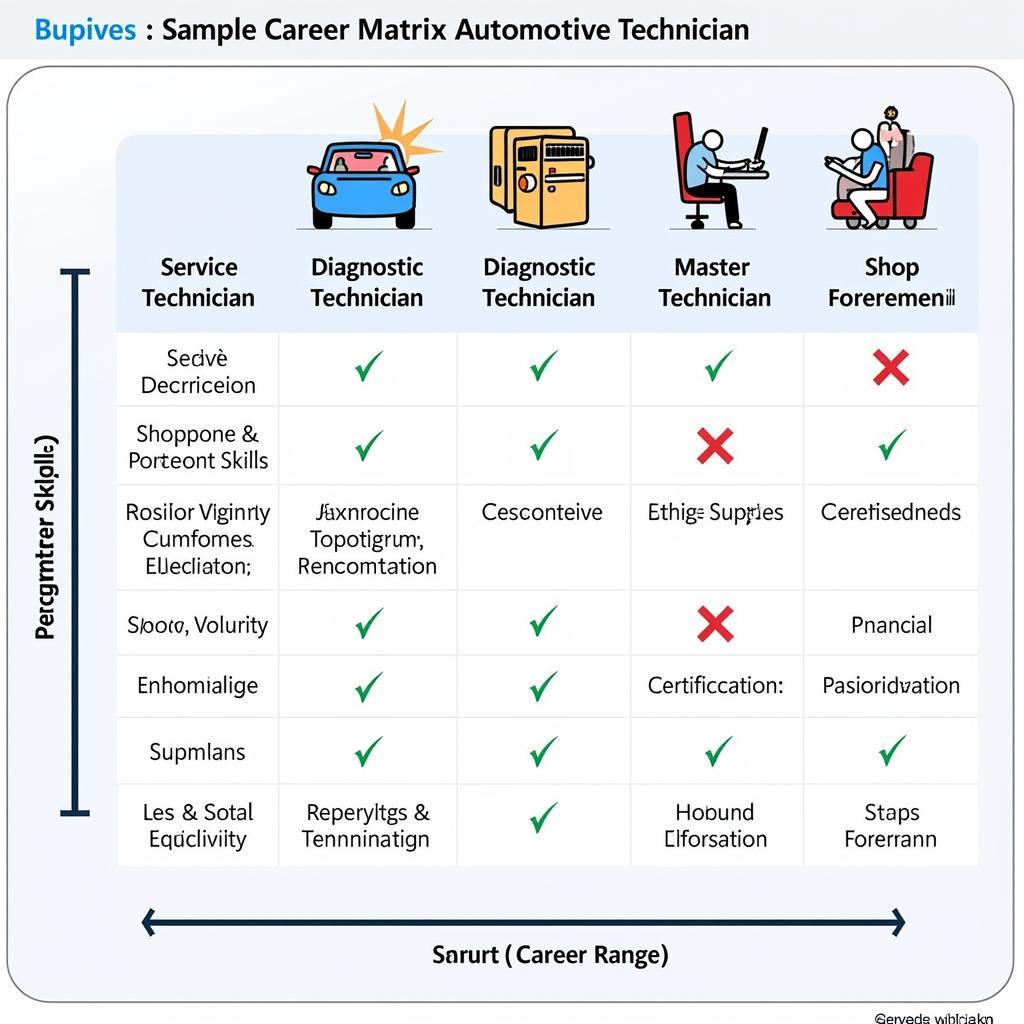Career Matrix Tools are essential for professional development, especially in the fast-paced automotive industry. They offer a structured approach to career progression, helping individuals and organizations align skills, identify gaps, and plan for future growth. This article provides an in-depth understanding of career matrix tools, their applications in the automotive sector, and how they can propel your career forward.
Understanding Career Matrix Tools
Career matrix tools, sometimes referred to as career ladders or progression frameworks, visually map out different career paths within an organization. They typically outline the skills, experience, and qualifications required for each role, providing a clear roadmap for advancement. These tools are invaluable for both employees seeking growth and employers looking to develop their workforce. They foster transparency and provide a shared understanding of career progression within the company. This helps employees visualize their future within the organization and motivates them to acquire the necessary skills for advancement.
 Example of a Career Matrix for an Automotive Technician
Example of a Career Matrix for an Automotive Technician
Benefits of Using Career Matrix Tools in the Automotive Industry
The automotive industry is undergoing rapid transformation with the advent of electric vehicles, autonomous driving, and advanced diagnostics. Career matrix tools are crucial for navigating this dynamic landscape. They enable professionals to stay ahead of the curve by identifying the evolving skill sets needed for success. Moreover, these tools support succession planning, ensuring that organizations have the right talent in place to meet future demands. They also contribute to a more engaged and motivated workforce.
How Career Matrices Empower Automotive Professionals
Career matrices offer several key benefits for automotive professionals:
- Clarity and Direction: They provide a clear understanding of career paths and the requirements for each role.
- Skill Development: They pinpoint skill gaps and guide professional development efforts.
- Motivation and Engagement: They offer a tangible path for advancement, boosting employee morale and motivation.
- Performance Management: They provide a framework for setting performance goals and measuring progress.
 Automotive Career Paths Matrix
Automotive Career Paths Matrix
Implementing Career Matrix Tools Effectively
Implementing career matrix tools requires a strategic approach. It’s essential to involve key stakeholders, including HR, management, and employees, to ensure buy-in and alignment. Regular review and updates are critical to keep the matrix relevant and reflective of industry trends.
Key Steps for Implementation
- Define Career Paths: Identify key roles and progression pathways within the organization.
- Outline Skill Requirements: Determine the essential skills, certifications, and experience needed for each role.
- Develop a Visual Matrix: Create a clear and easy-to-understand visual representation of career paths and requirements.
- Communicate and Train: Ensure all employees understand how to use the career matrix and its benefits.
- Regularly Review and Update: Keep the matrix up-to-date to reflect changes in the industry and organizational needs.
Career Matrix Tools and the Future of Automotive Diagnostics
As vehicle technology becomes increasingly complex, the role of diagnostic technicians is evolving rapidly. Career matrix tools are vital for ensuring that these professionals possess the skills needed to diagnose and repair advanced vehicle systems. These tools can help map out the specialized training and certifications required for working with electric vehicles, hybrid systems, and advanced driver-assistance systems (ADAS).
 Diagnostic Technician Career Matrix: Future Technologies
Diagnostic Technician Career Matrix: Future Technologies
Conclusion
Career matrix tools are indispensable for navigating the dynamic automotive landscape. By providing a structured approach to career development, they empower individuals to reach their full potential while enabling organizations to build a skilled and future-ready workforce. Leveraging these tools is crucial for staying ahead in the ever-evolving world of automotive technology. Adopting career matrix tools is a strategic investment in the future of your automotive career.
addgene blog earli career survivor tools
FAQs
- What is a career matrix? A career matrix is a visual tool that outlines different career paths and the skills required for each role.
- How can a career matrix benefit me? It can provide clarity, guide skill development, and boost motivation by providing a clear path for advancement.
- How often should a career matrix be updated? Regular review and updates are essential to ensure the matrix reflects current industry trends and organizational needs.
- Are career matrices only for large organizations? No, they can be beneficial for organizations of all sizes.
- How can I create a career matrix for my team? Start by defining key roles, outlining skill requirements, and developing a visual representation.
Common Scenarios
- Scenario 1: A junior technician wants to become a master technician. The career matrix shows the required certifications and experience.
- Scenario 2: A service advisor wants to move into management. The matrix highlights the necessary skills and training.
Further Exploration
For more information on career development in the automotive industry, explore resources on addgene blog earli career survivor tools.
Need assistance with car diagnostics or have questions about career paths in the automotive industry? Contact us via WhatsApp: +1(641)206-8880, Email: [email protected] or visit us at 910 Cedar Lane, Chicago, IL 60605, USA. Our customer support team is available 24/7.

Leave a Reply